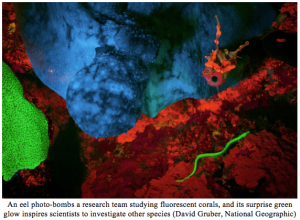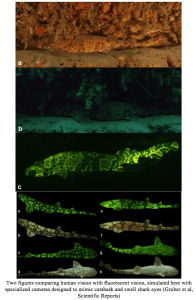
You’ve probably heard of bioluminescence, where some ocean animals make their own light to communicate, attract prey, or distract predators. But did you know that much of the ocean world is already glowing in a way that’s invisible to your naked eye? Many corals, more than than 180 species of fish, some sharks, at least three types of eels, and one critically endangered sea turtle, the Hawksbill, would actually display neon colors if you were to shine a black light or UV light on them, in a phenomenon called biofluorescence.
 That’s right: When stimulated by UV light, these creatures produce all sorts of flashy colors, from reds to greens to eerie iridescent purples. Unlike bioluminescence, these types of light signatures depend on a light source, and are typically invisible to the human eye. That’s why, until as recently as 2014, researchers didn’t know that other marine species besides coral were capable of this type of biofluorescence. In fact, it wasn’t until an eel accidentally “photo-bombed” a video shoot of coral under a UV light (below) that marine biologists began to investigate this capability in other animals!
That’s right: When stimulated by UV light, these creatures produce all sorts of flashy colors, from reds to greens to eerie iridescent purples. Unlike bioluminescence, these types of light signatures depend on a light source, and are typically invisible to the human eye. That’s why, until as recently as 2014, researchers didn’t know that other marine species besides coral were capable of this type of biofluorescence. In fact, it wasn’t until an eel accidentally “photo-bombed” a video shoot of coral under a UV light (below) that marine biologists began to investigate this capability in other animals!
 Why do they do it?
Why do they do it?
Scientists don’t know why creatures biofluoresce, but some hypothesize that it may be a form of complex communication with only other creatures who may see these unique UV emissions. For example, sharks eyes are adapted with special color filters that allow them to see the biofluorescent signals of other animals, which could allow them to pass signals back and forth.

How does it work?
Fluorescence happens when high intensity electromagnetic energy, such as UV light, excites an electron so that it jumps to a high-energy, unstable state. As the electrons fall back down to their natural resting place in the atom, they releases excess energy in the form of photons, or small packets of light, and the result is a colorful glow. This principle is used often in biological microscopy (illustrated below).

How do we know?
While we don’t know much about biofluorescence yet, many scientists are undertaking studies to determine more about how it works and what purpose it might serve. To capture fluorescence, a photographer must shine high intensity blue light on an animal and then photograph it using a camera with a yellow filter that blocks out the blue, allowing the fluorescence to shine through. Dr. David Gruber and his team recently built “sharks-eye” view cameras to simulate fluorescent vision and investigate the underwater world from a fish-eye view. What they found was an amazing Technicolor carnival, starring many of the creatures we can find in our own coves at CIMI: Scorpionfish, swell sharks, and round rays!
What’s the deal with this secret underwater light show? It’s just one more mystery of the deep!
For more, check out:
- http://www.nature.com/articles/srep24751/figures/13
- https://www.forbes.com/sites/grrlscientist/2016/04/30/biofluorescent-sharks-glowing-messages-revealed-by-shark-vision-camera/#77845de8d700
- http://www.alertdiver.com/?articleNo=2141


